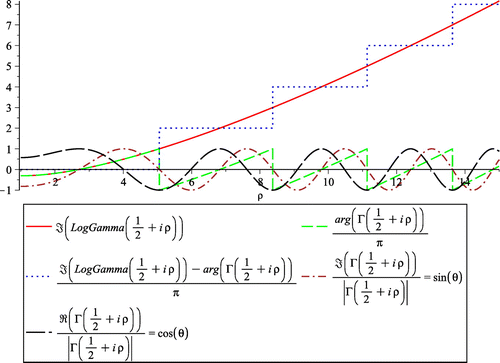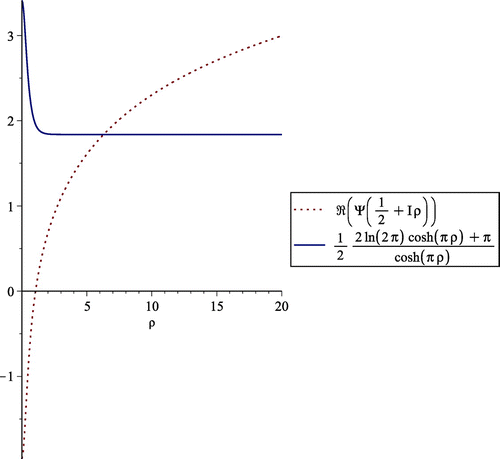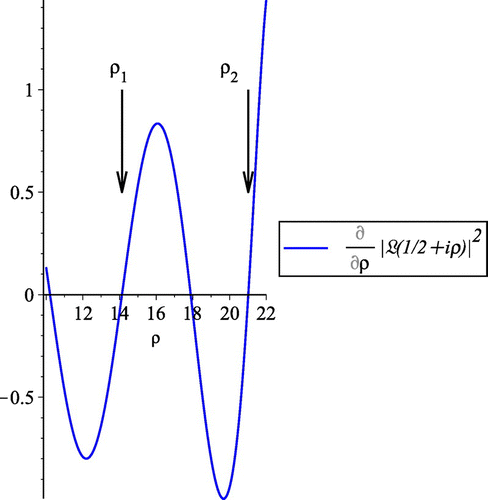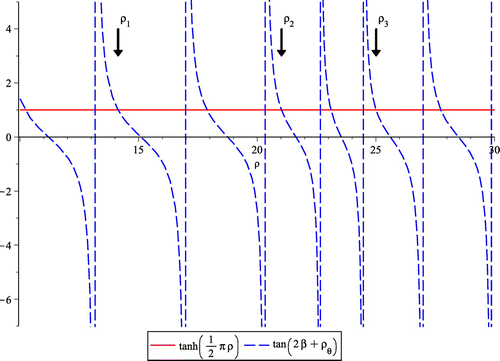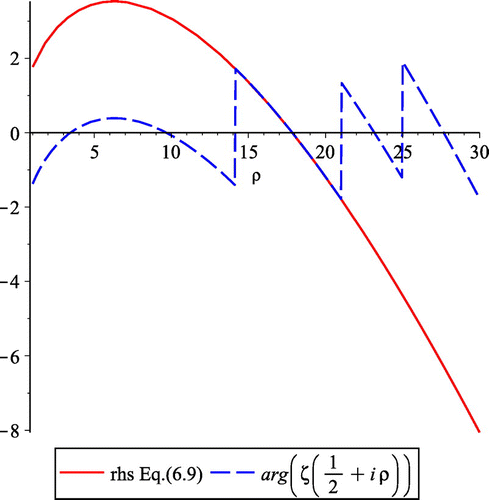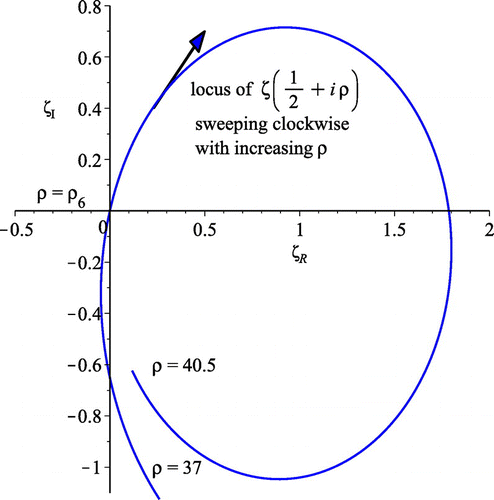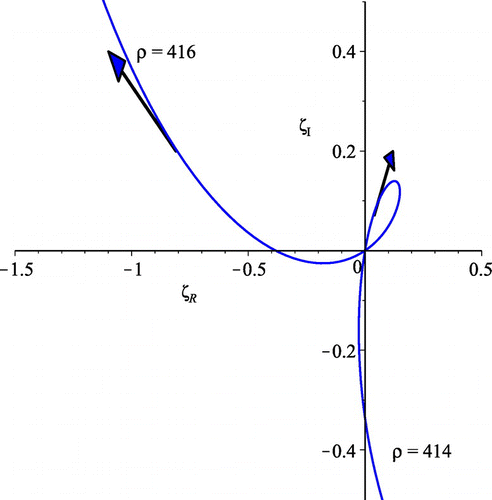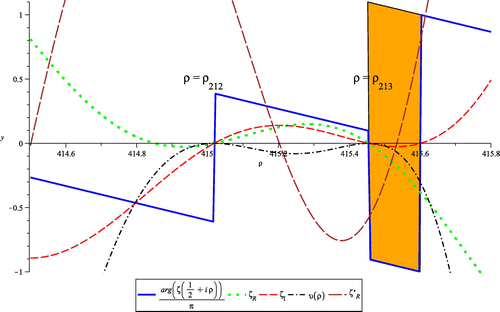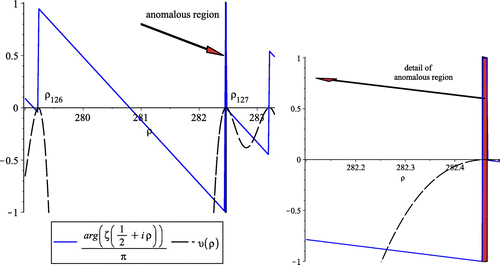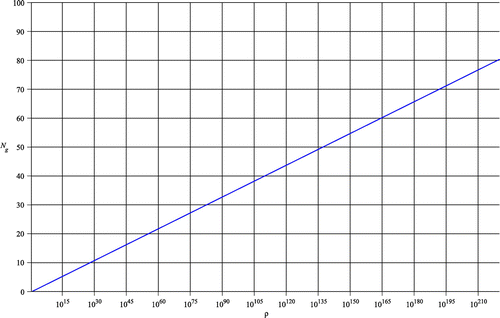 ?Mathematical formulae have been encoded as MathML and are displayed in this HTML version using MathJax in order to improve their display. Uncheck the box to turn MathJax off. This feature requires Javascript. Click on a formula to zoom.
?Mathematical formulae have been encoded as MathML and are displayed in this HTML version using MathJax in order to improve their display. Uncheck the box to turn MathJax off. This feature requires Javascript. Click on a formula to zoom.Abstract
An equivalent, but variant form of Riemann’s functional equation is explored, and several discoveries are made. Properties of Riemann’s zeta function , from which a necessary and sufficient condition for the existence of zeros in the critical strip, are deduced. This in turn, by an indirect route, eventually produces a simple, solvable, differential equation for
on the critical line
, the consequences of which are explored, and the “LogZeta" function is introduced. A singular linear transform between the real and imaginary components of
and
on the critical line is derived, and an implicit relationship for locating a zero (
) on the critical line is found between the arguments of
and
. Notably, the Volchkov criterion, a Riemann Hypothesis (RH) equivalent, is analytically evaluated and verified to be half equivalent to RH, but RH is not proven. Numerical results are presented, some of which lead to the identification of anomalous zeros, whose existence in turn suggests that well-established, traditional derivations such as the Volchkov criterion and counting theorems require re-examination. It is proven that the derivative
will never vanish on the perforated critical line (
). Traditional asymptotic and counting results are obtained in an untraditional manner, yielding insight into the nature of
as well as very accurate asymptotic estimates for distribution bounds and the density of zeros on the critical line.
Public Interest Statement
Prime numbers have fascinated mathematicians since the invention of arithmetic. One of the main discoveries by Bernhard Riemann, one of the greatest nineteenth-century mathematicians, was a link between what is called the “Riemann Zeta function” and the distribution of prime numbers. Since then, mathematicians (and others) have been studying zeta function properties and slowly unveiling its secrets. This is important because prime numbers form the basis for the major encryption algorithms in use today. If you indulge in Internet banking or commerce, you are using prime numbers.
In this paper, a new relationship is deduced that equates an arcane property of the zeta function to simpler mathematical entities whose properties are well known. As an anonymous referee has stated: “... such relation ... would lead to extremely important consequences”. Additionally, a surprising numerical discovery is presented which calls into question many previously thought-to-be-well-founded results.
1. Introduction
The course of other work has led to an exploration of a not-so-well-known variant of Riemann’s functional equation. Thought to be equivalent to the classical equation that relates the functions and
, the variant studied here relates
and its derivatives
and
. As has been discovered elsewhere (e.g. Guillera, Guillera, Eq. 10; Spira, Citation1973), this variant has proven to be a surprisingly rich source from which possible new properties of
can be unearthed. At a minimum, the rediscovery of previously known results is obtained in a completely different manner from the usual textbook and literature approach. This report is a summary of those explorations.
In Section 2, the notation and other results drawn from the literature are summarized. Section 3 recalls the variant functional equation, from which it is possible to infer the existence of a functional relationship between and
that yields necessary and sufficient implicit conditions for locating points
such that
. The main result of the next two sub-sections (4.1) and (4.2) is the derivation (and rediscovery) of two implicit, and later shown-to-be-equivalent, equations whose solution(s) locate zeros on the critical line
. In a third sub-section (4.3), a singular linear transformation relating the real and imaginary components of
and
is presented, generating a third implicit equation for locating the non-trivial zeros. Prior to presenting an analytic solution to the first two of these equations in Section 7, and noting the numerical equivalence of the third, the development digresses.
Section 5 introduces a related functional with interesting properties, and in Section 6, those properties are employed to obtain and solve a simple differential equation satisfied by and thereby introduce the LogZeta function, in complete analogy to the well-known LogGamma function (England, Bradford, Davenport, & Wilson, Citation2013; Wolfram MathWorld, Citation2005). Amalgamating all those results in Section 7 yields requisite conditions for the existence of
such that
, reproducing similar results obtained elsewhere (de Reyna & Van de Lune, Citation2014). In Section 8, by analytic integration, the properties of
are used to ostensibly verify that the Volchkov Criterion (Volchkov, Citation1995), advertised as “equivalent" to the Riemann Hypothesis (RH), possesses one-half of that property. Although this does not lead to a proof of RH, it does lead to some insight about the usefulness of so-called “Riemann equivalences" (Conrey & Farmer, Citationn.d.). However, the subsequent Section 9 shows that much of the foregoing, as well as well-known classical results, are in need of revision because of the peculiar numerical properties of
, from which the phenomenon of anomalous zeros is identified. Additionally, the results from Section 6 lead to a proof (in Section 10) that
on the perforated critical line without recourse to RH, almost closing the last gap in an investigation initiated many years ago (e.g. Spira, Citation1973). Section 11 investigates the asymptotic behaviour of
, again reproducing known results. In Section 12, these results are reused to deduce estimates that provide upper and lower bounds for locating the k’th zero on the critical line, as well as the density and maximum separation of such points. In a numerical diversion, the claimed location of zero number “googol" (França & LeClair, Citation2013) is tested; it is found that the value as declared should probably be googol-1, although its position on the critical line appears to be accurate within the resolution provided. (Aside: The word “googol" traditionally refers to the number
and is easily confused with the similarly sounding word “google" usurped by a well-known search engine.)
Throughout, some derivations require considerable analytic perseverance to deal with expressions involving many terms. Such derivations are noted, and are left as exercises for the reader with the suggestion that a computer algebra program be utilized. In general, these computations, although lengthy, do not involve anything other than the use of well-known trigonometric and other identities involving Gamma and related functions (Olver, Lozier, Boisvert, & Clark, Citation2010). An example of such a calculation, in which the differential Equation (6.1) can be found as part of the supplemental material which may be accessed by a hyperlink following Section 14. A list of notations and symbols will be found in Appendix 1. The Maple computer code (Maplesoft, A Division of Waterloo Maple, Citation2014) is the source used for many of the calculations contained here. When that occurs, references to Maple are simply indicated in the text by the word Maple in parenthesis, in order that calculations can be reproduced,
2. Preamble
A number of known results and notation, required in forthcoming Sections, are quoted here. A basic result used throughout employs the polar form of as
(2.1)
(2.1)
differing by a sign from that used elsewhere (de Reyna & Van de Lune, Citation2014). Specific to the “critical line" , the specialized form is written
(2.2)
(2.2)
where explicit dependence on the variable is usually omitted for clarity. Throughout, subscripts “R" and “I" refer to the real and imaginary parts of the associated symbol, respectively; all derivatives are taken with respect to
and, always,
. On the critical line, the arguments
and
of associated functions are defined by
(2.3)
(2.3)
(2.4)
(2.4)
For use in later sections, define(2.5)
(2.5)
This function has a simple pole at , and for
,
. See Section 3.
Although the real functions and
are (almost) independent, known relationships (de Reyna & Van de Lune, Citation2014, Proposition 7 and equivalently Milgram, Citation2011, Eqs. 3.1, 3.2 and Appendix B) exist between the real and imaginary components of
, specifically
(2.6)
(2.6)
where(2.7)
(2.7)
An equivalent form of (Equation 2.7) can be obtained by writing its various terms in polar form, using the representation (de Reyna & Van de Lune, Citation2014, Eq. 4)(2.8)
(2.8)
alternatively giving(2.9)
(2.9)
where the various symbols in the above are defined in Appendix 1. Curiously, relevant to the well-known result (Titchmarsh & Heath-Brown, Citation1986, Eq. 4.17.2)(2.10)
(2.10)
and left as an exercise for the reader, it may also be shown that(2.11)
(2.11)
if is replaced by
in the definition (Equation 2.7). As has been obtained elsewhere (Milgram, Citation2011, Eq. 3.7), in the case that
, corresponding to a non-trivial zero
, the ratio of those quantities appearing on the left-hand side of both (Equation 2.7 and 2.9) satisfies
(2.12)
(2.12)
when the zero is of order n, where , in terms of the appropriate
derivatives, by invoking l’Hôpital’s rule. Also see Equations (6.3 and 6.4) below. Another result that will prove useful is obtained by direct differentiation of Equation (2.2), that being
(2.13)
(2.13)
where(2.14)
(2.14)
An important distinction must be made between discontinuous functions corresponding to, and denoted by, the notation “arg” and their continuous, multi-sheeted counterparts—the two entities differ by a constant equal to and k is always an integer. As an example, consider Figure where the imaginary part of the multi-sheeted function (Wolfram MathWorld, Citation2005) LogGamma
is compared to the discontinuous function
, in both cases as a function of
. The difference, normalized by
is also shown, to demonstrate that it is always an integer “constant", which, however, changes at each discontinuous point of the arg operator. As indicated in the Figure, discontinuities of the argument are associated with a sign change of
coincident with
—that is, whenever
, and the discontinuity is
. In Section 9, a similar comparison is made using the function
.
3. The basic functional equation
The following proofs of sufficiency and necessity are valid if is a simple zero. See Section 10.
3.1. A sufficient condition that 

From the functional equation for , that is,
(3.1)
(3.1)
we have (Guillera, Guillera, Eq. 10 - misprinted; Spira, Citation1973, Eq. 1)(3.2)
(3.2)
valid for all s. Alternatively, in equivalent form, define the normalized right- and left-hand sides of Equation (3.2) by(3.3)
(3.3)
and(3.4)
(3.4)
in which case Equation (3.2) can be written(3.5)
(3.5)
Since it is known (Spira, Citation1973) that in the open critical half-strip
, the following requires that s be constrained to that region, although the known symmetry imposed by the functional equation, viz.
implies
and the reverse, means that the following can be generalized to
. We now show that
is a necessary and sufficient condition for
. Suppose
such that
(3.6)
(3.6)
Clearly, if Equation (3.6) is true, or, alternatively(3.7)
(3.7)
then the right-hand side of Equation (3.2) vanishes; that is,(3.8)
(3.8)
unless, for that same value of , the factor
(3.9)
(3.9)
Is it possible that Equations (3.7 and 3.9) can be simultaneously true for some value(s) of ? On the perforated critical line, where it will shortly be shown (see Section 10) that
, solving Equation (3.9) requires that
must satisfy
(3.10)
(3.10)
and from Figure , we see that this condition is only satisfied at a single point because the right-hand side of Equation (3.10) approaches
asymptotically, whereas the left-hand side is monotonically increasing as
(Olver et al., Citation2010, Eq. 5.11.2). In this case, the imaginary counterpart of Equation (3.9) vanishes. Because this point does not coincide with a zero of
, on the critical line, Equation (3.6), or equivalently Equation (3.7), is a sufficient condition for Equation (3.8) to be true, unless
, a constant quoted to many significant figures in de Reyna and Van de Lune (Citation2014, Corollary 9). See also Section 10 - Note 1.
Now, consider the general case with
—the lower half of the “critical strip". A hypothetical solution of Equation (3.9) requires the existence of solutions
simultaneously satisfying
(3.11)
(3.11)
and(3.12)
(3.12)
If , Equation (3.11) reduces to Equation (3.10) and (3.12) reduces to an identity (NIST Digital Library of Mathematical Functions, Citation2014, Eq. 5.4.17). A numerical study of Equation (3.11) for
shows that a single solution exists when
, similar to that shown in Figure , but otherwise, there are no numerical solutions for the previous reasons. Similarly, the left-hand side of Equation (3.12) asymptotically approaches its right-hand side as
, but the equality is never satisfied. Therefore, the existence of a point
solving Equation (3.7) is a sufficient condition for a zero of
to exist because the Equations (3.7 and 3.9) do not simultaneously vanish.
By a way of illustration, consider Figure which shows for two different choices of
near the first two known non-trivial zeros of
. Because of the above, this Figure immediately suggests that
unless
.
3.2. A necessary condition that 

From the functional Equation (3.1), implies
. If
, then
, since the other factors of
do not diverge if
(corresponding to the existence of the so-called trivial zeros). From Equation (3.5), this implies
and necessity follows because
except possibly at a zero (see Section 10). This proves necessity subject to the simplicity of a zero.
4. Implicit specification of zeros along the critical line
4.1. First implicit specification of the zeros along the critical line
Inspired by Figure () and Equation (3.7) that together demonstrate that implicit numerical solutions of the equation locate the zeros of
, consider the related equation
(4.1)
(4.1)
After considerable effort (Maple) to simplify (Equation 4.1) (left as an exercise for the reader with access to a computerized algebraic manipulation program), we find(4.2)
(4.2)
For any value of corresponding to
and
(see Section 10) on the left-hand side of Equation (4.2), the right-hand side of this equation must accordingly vanish as well because the remaining factors on the left-hand side never vanish if
. This produces an implicit equation that locates
:
(4.3)
(4.3)
This will be discussed further in Section 7.
4.2. Second implicit specification of the zeros along the critical line
Again inspired by Figure (), we obtain a second implicit equation whose zeros coincide with the non-trivial zeros of . Working from the real and imaginary parts of
(4.4)
(4.4)
(4.5)
(4.5)
consider the function(4.6)
(4.6)
at least some of whose zeros must coincide with the maxima and minima of
.
Following a lengthy calculation (Maple), we find(4.7)
(4.7)
where again the various symbols in Equation (4.7) are defined in Appendix 1.
Figure demonstrates that passes through the first two zeros of
with positive slope, and, as expected, alternating solutions corresponding to zeros of Equation (4.7) implicitly define those points
such that
=0, consistent with the assumption that
does not contain intermediate maxima, minima or inflections. Of particular interest is the fact that Equation (4.7) consists of two factors that could potentially vanish. From a numerical study, the first of these, enclosed in square brackets ([...]), appears to be negative for all values of
. If so, the factor
(see Appendix 1) carries all the zeros of
, from which we conclude that solutions of
correspond to alternating solutions of
(4.8)
(4.8)
See Figure . This will be discussed further in Section 7.
4.3. Third implicit specification of the zeros along the critical line
With , from Equation (3.2 and 2.5), we find
(4.9a)
(4.9a) where
(4.10)
(4.10)
(4.11)
(4.11)
(4.12)
(4.12)
and we reiterate (from Appendix 1) that .
It is easily shown that the determinant of the transformation matrix Equation (4.9) is identically zero, and therefore the transformation is singular. This suggests that in some sense, the components of the derivative function are more fundamental than are the components of the primary function
. That is, Riemann’s functional equation in the form Equation (3.2) defines the latter from the former, but not the other way around, suggesting that something has been lost when Equation (3.2) is generated from the usual form of the functional Equation (3.1). Why should this be? This may be analogous to the fact that the act of differentiation followed by integration always introduces an arbitrariness in the form of a constant. Or, it may be due to the fact that differentiating (Milgram, Citation2011, Eqs. 3.1 and 3.2) with respect to
will always give a result where
and
are a mixture of
and
that cannot be disentangled in the form of an inverse transform of Equations (4.9a) and (4.9b).
In Section 10, it is shown that with conditions. Thus, setting the left-hand sides of Equations (4.9a and 4.9b) to zero will result in a relationship between the various components of these equations at a zero of
. Specifically,
satisfying the following
(4.13)
(4.13)
and(4.14)
(4.14)
defines all the non-trivial zeros on the critical line plus one extra zero associated with the factor . The results (Equations 4.13 and 4.14) can be consolidated by equating the ratio of the two left-hand sides in the form
(4.15)
(4.15)
with a similar expression for the right-hand sides. The standard two parameter function is specified to consistently account for the signs of the various terms. Alternatively, solving Equations (4.13 and 4.14) for the ratio
gives
(4.16)
(4.16)
corresponding to a solution for at a non-trivial zero
. See Section 7.
5. A related functional
Formally replace with
in Equation (3.4) and using Equation (3.1), define and evaluate
(5.1)
(5.1)
For the particular case , using standard trigonometric and Gamma function identities (e.g. Olver et al., Citation2010, Eq. 5.4.4), it is easy to establish that
(5.2)
(5.2)
It now becomes possible to use (Equation 5.2) to discover interesting results because of Equation (3.5). Define the modified right-hand side of Equation (3.5) corresponding to Equation (5.1) with by adding and subtracting the terms that convert
into
, specifically
(5.3)
(5.3)
Then, from Equation (5.2), we have(5.4)
(5.4)
6. 
 and related entities
and related entities
After algebraic simplification, Equation (5.4) eventually yields(6.1)
(6.1) (Background note: This is a fairly lengthy, but straightforward calculation. First, break
into its real and imaginary parts using Equations (3.3 and 5.3), evaluate
and simplify the resulting Equation (5.4). The simplification sequence involves nothing more than the application of well-known identities involving
and related functions. Due to the complexity and length of this calculation, the details are left as an exercise for the reader, who may consult a supplementary file which can be accessed by a hyperlink following Section 14—that being an annotated Maple worksheet used to reproduce the calculation. A second, equally lengthy, but independent derivation of Equation (6.1) has recently been obtained—ms. in preparation).
Setting in Equation (6.1) reproduces a known relationship between
and
. Furthermore, noticing that
(6.2)
(6.2)
by recalling that(6.3)
(6.3)
and(6.4)
(6.4)
we recognize Equation (6.1) to be a simple differential equation(6.5)
(6.5)
or, equivalently(6.6)
(6.6)
where(6.7)
(6.7)
Integrating (Equation 6.6) between and
gives
(6.8)
(6.8)
where the arbitrary constant has been chosen such that
corresponds to a consistent answer when
. This result is equivalent to de Reyna and Van de Lune (Citation2014, Eq. 8) when
and
, in which case we find
(6.9)
(6.9)
It is important to recognize that in Equation (6.6) is a continuous function, whereas its companion
is discontinuous, and therefore the solution (Equations 6.8 or 6.9) only applies in a multi-sheeted sense. That is, in order to satisfy Equation (6.6), in each of Equation (6.8 or 6.9), k serves as a local variable, constant over a range where
is continuous, but effectively,
globally. See Section 9 for further discussion, and Section 8 for an application of this point.
The integral in Equation (6.9) can be evaluated analytically, using the well-known expansion (NIST Digital Library of Mathematical Functions, Citation2014, Eq. 5.7.6)(6.10)
(6.10)
First, temporarily omit the operator, then interchange the sum and integration operators, and, after the (trivial) integration is accomplished, compute the real part of the result, and sum the resulting series utilizing (Hansen, Citation1975, Eq. 42.1.5)
(6.11)
(6.11)
to obtain (see de Reyna & Van de Lune, Citation2014, Section 3; also see Section 12, Equation 12.2, below where it is pointed out that this result can be simply obtained by integrating by parts)(6.12)
(6.12) (Digression: It is worth noting that an equivalent, but unevaluated, form of the sum in Equation (6.11) arises in de Reyna and Van de Lune (Citation2014, Eq. 9) where it is suggested that it is perhaps new. In Hansen (Citation1975), this result is attributed to Abramowitz and Stegun (Citation1964, Eq. 6.1.27), and, somewhat surprisingly, it appears to have been omitted from (NIST Digital Library of Mathematical Functions, Citation2014). See also (Wolfram MathWorld, Citation2005) where this sum is used to define the LogGamma function. Of course
(6.13)
(6.13)
and the multi-sheeted LogGamma function of argument differs from the function
by an additive term equal to
.) With this result, Equation (6.8) now becomes
(6.14)
(6.14)
and, in the case that ,
(6.15)
(6.15)
Notice that in Equation (6.6) and
in Equation (6.14) differ from substitute symbols (
and
) in Equations (2.13 and 2.14) because of the ambiguity associated with the term
. Also, the discontinuities on both sides of Equations (6.14 and 6.15) do not coincide—for any value of
, a corresponding value of k must be carefully chosen. From Equation (6.9), it becomes convenient to define the multi-sheeted (i.e. continuous) LogZeta function (see Figure ):
(6.16)
(6.16)
In this form, and throughout this work, associates with LogZeta function via
(6.17)
(6.17)
and represents the LogGamma function in the same way (England et al., Citation2013). Using this definition, we have
(6.18)
(6.18)
Finally, from Equation (2.7), we obtain(6.19)
(6.19)
and an equivalent form if Equation (2.9) is used.
7. Locating the zeros on the critical line
Write Equation (4.3) in generic form(7.1)
(7.1)
Solutions to Equation (7.1) exist when(7.2)
(7.2)
provided that (when n is even)(7.3)
(7.3)
or (when n is odd)(7.4)
(7.4)
By comparison of Equation (7.2) with Equations (4.3 and 6.15), we identify(7.5)
(7.5)
consistent with de Reyna and Van de Lune (Citation2014, Proposition 17). Taking advantage of the arbitrariness of the arg operator modulo , it is thus possible to solve Equation (7.1) in a simpler form and conclude that alternating solutions of
(7.6)
(7.6)
locate zeros of on the critical line, where K is an integer, a result that is easily verified numerically, or analytically for any combination of n and (constrained)
in Equations (7.3 and 7.4). Equation (7.6) also reproduces de Reyna and Van de Lune (Citation2014, Proposition 13).
Insofar as alternative means of locating zeros are concerned, it is easily shown by simple trigonometric identities that Equation (7.2) is also a valid solution to Equation (4.8); therefore Equation (4.8) is algebraically equivalent to Equation (4.3). Although not obvious, it turns out that Equation (4.16) is also (numerically) equivalent to Equations (4.3 and 4.8). In contrast, solutions satisfying(7.7)
(7.7)
correspond to the in-between solutions of Equation (7.1), i.e. the maxima of in Figure . Any of Equation (4.3), Equation (4.8) or Equation (4.16), treated as implicit equations, are numerically sensitive means of locating a zero because the two sides intersect one another at differing slopes (e.g. Figure ), as opposed to treating either side of Equation (4.1) implicitly because those “intersections" occur at tangent points. Another effective numerical variation, also equivalent to Equation (2.12), yields the following simple corollary to Equation (7.6):
whenever
satisfies
(7.8)
(7.8)
Any of these prescriptions, employed as a numerical means of locating zeros, give the appearance of requiring knowledge of both and
(i.e. both
and
need to be calculable). In fact, because of Equation (6.15), only
needs to be calculable, along with variations of
and related functions which are presumably well-known numerically. This is especially effective if Equation (6.19) is employed to represent the term
in Equation (7.8).
8. The Volchkov equivalence
With reference to Equation (8.1) below, (where it has been opined (Moll, Citation2010) “Evaluating (it) might be hard"), given an explicit expression for (see Equation 6.9), it now becomes possible to investigate the Volchkov Criterion, the truth of which is advertised as being equivalent to RH (Conrey & Farmer, Citationn.d.; He, Jejjala, & Minic, Citation2015, Eq. 2.3; Volchkov, Citation1995; Sekatskii, Beltraminelli, & Merlini, Citation2012; Borwein, Choi, Rooney, & Weirathmueller, Citation2008, Section 5.2). This criterion reads: “The Riemann Hypothesis is equivalent to
(8.1)
(8.1)
Several variations of Equation (8.1), all of which are based on a similar derivation method, are presented in these references. Consider Figure , a numerical comparison between the right-hand side of Equation (6.9) and spanning the first few zeros of
along the critical line. This comparison demonstrates that the “constant" k in Equation (6.9) must be carefully chosen to achieve equality between the two representations of
. In Figure , we note the existence of a discontinuity in
at
. In fact,
(8.2)
(8.2)
a property that is shared (within a sign change) with any analytic function at a simple zero because the real and imaginary parts of the function both change sign as the zero is traversed in the complex plane. (See Section 10). The intent now is to analytically evaluate Equation (8.1) using the right-hand side of Equation (6.9) to represent
.
Substituting Equation (6.9) into Equation (8.1) leads to three interesting integrals, the first being(8.3)
(8.3)
which may be evaluated by first integrating by parts,(8.4)
(8.4)
eventually yielding(8.5)
(8.5)
after consulting Gradshteyn and Ryzhik (Citation1980, Eqs. 3.522(4) and 8.370). The second required integral is(8.6)
(8.6)
Following the method of Equation (6.10), interchange the integral and sum, and after evaluating the real part of the integral, obtain(8.7)
(8.7)
Apply the outer integration to the first two of the terms in Equation (8.7), and find (courtesy of Maple)(8.8)
(8.8)
(8.9)
(8.9)
To evaluate the third term in Equation (8.7), interchange the convergent (grouped) sum with the outer integration and evaluate the integral (Maple), which yielding(8.10)
(8.10)
Sum the resulting series (Maple), incorporate Equations (8.8 and 8.9) and eventually arrive at(8.11)
(8.11)
The third integral, corresponding to the term in Equation (6.9), is needed to account for the area between the continuous and discontinuous functions in Figure . Temporarily guided by Figure and Equation (8.2) which indicate that each continuous segment of
is bounded by the
zero of
(but see Section 9), split the integration limits into intervals, leading (Maple) to:
(8.12)
(8.12)
The series in Equation (8.12) is first decomposed by partial fractions and since grouped terms (partially) cancel, the final form of the series becomes(8.13)
(8.13)
which can be written(8.14)
(8.14)
where represents all zeros of
that lie on the critical line, and the overall factor
has been included in recognition of the fact that the sum now includes complex conjugate values that were not included in the original sum (Equation 8.13), indicated by the use of
. A more general form of the sum (8.14) is known (Edwards, Citation2001, p. 159), its value being
(8.15)
(8.15)
where the sum over includes all zeros of
, including any that may not lie on the critical line. If RH is true (that is,
for all
), then the sums in Equations (8.14 and 8.15) coincide, yielding
(8.16)
(8.16)
Finally, we have the less interesting integrals to evaluate, specifically (Maple)(8.17)
(8.17)
and(8.18)
(8.18)
Putting all the parts together, that is(8.19)
(8.19)
gives(8.20)
(8.20)
with(8.21)
(8.21)
where the sum over in
only includes zeros of
that do not lie on the critical line, indicated by the symbol
. The term
arises from the difference between the terms included in the sums appearing in Equations (8.14 and 8.15), assuming RH to be false. It is worth noting that individual terms in the sum (Equation 8.20) are positive, so there is no possibility that a sum composed of non-zero terms could itself vanish—its contribution would always be negative. With
, the claim Equation (8.1) is verified, but it does NOT prove the Riemann Hypothesis which postulates that
vanishes; it only verifies the equivalence of Equation (8.1) and the RH as embodied in Equation (8.15) because the verification is contingent on the equality of the sums in Equations (8.14 and 8.15), which itself depends on the RH.
This unsurprising result merits further discussion and raises the question of the value of so-called “RH equivalences" to prove RH. In the first place, the original wording: “RH is equivalent to Equation (8.1)" is not very well chosen because the word “equivalent" implies a two-way correspondence (of truth); the original wording should have been: “If RH is true then Equation (8.1)" without implying the converse. This interpretation can be established by examining the derivation of Equation (8.1) which was based on a contour integration about a region where zeros of were presumed not to exist. Fundamentally, Equation (8.1) could have been obtained in two different ways: “If RH then Equation (8.1)" or “If not RH then Equation (8.1) plus additional terms (i.e.
)". In fact, such terms are explicitly presented, but omitted in the derivation (see Sekatskii et al., Citation2009, unnumbered equation terminating Section 3.1, Power functions) and a long discussion in He et al. (Citation2015). Consequently, irrespective of which assumption is used to obtain Equation (8.1), subsequent analysis (e.g. as presented here) must be done under that same assumption, and a proof (or disproof) of RH will only emerge if either assumption, used consistently throughout, yields a contradiction (reductio ad absurdum). Otherwise, the best that can be hoped for will be a tautology. That is what has happened here.
The original derivation of Equation (8.1) was performed under the first assumption (RH is true) and, if the above analysis (Section 8) had been done with that same assumption, the term appearing in Equation (8.19) would not have been present. The result would have been a tautology: rhs of Equation (8.1) = rhs of Equation (8.19) (without
). Alternatively, if the original derivation of Equation (8.1) had been done under the premise “RH is not true", then additional terms, exactly equivalent to
as it appears in Equation (8.19), would have been present in Equation (8.1) in agreement with the subsequent analysis (performed above) under that same assumption. The result would be, and is, again a tautology: rhs of Equation (8.1) (plus
) = rhs of Equation (8.19). Sans contradiction, neither of these can prove or disprove RH. All of this suggests that a proof of RH will never be obtained by inventing so-called “equivalences" that depend on hypothesizing that zeros off the critical line do, or do not, exist. However, in this case, it is a useful exercise to demonstrate the validity of Equation (6.9) and conveniently suggest some RH-independent results by examining other tacit assumptions that have been incorporated into the analysis.
First, the foregoing analysis provides a simple demonstration that the sum appearing in Equation (8.12) is convergent, for the simple reason that it equals a collection of terms that are all finite, without recourse to conditions. The transition from Equation (8.12) to Equation (8.14) involves a regrouping of terms, so it does not prove that Equation (8.14) is unconditionally convergent. A complicated proof of the convergence of Equation (8.14) can be found in many sources (e.g. Edwards, Citation2001). Secondly, it suggests that a careful numerical evaluation of Equation (8.1) or one of its various relatives can be used to place bounds on the smallest value of associated with a term of the sum appearing in Equation (8.20) (see Sekatskii et al., Citation2015, where an exponential weight function is appended). Thirdly, it appears to validate counting theorems that place bounds on the location of the zeros (see Section 12) by the presence of discontinuities of the argument. It will now be shown that all of the above are compromised.
9. But...But...But
9.1. A close look at the zeros
As noted above, verification of Equation (8.1) given here, depends on Equation (8.2). In general, a discontinuity of the arg operator for any analytic function h(z) can be associated with either of two events. The first is associated with the presence of a zero of order n, viz.(9.1)
(9.1)
Specializing to the case , it is easily shown that if
possesses a zero of order n at
, Equation (8.2) becomes
(9.2)
(9.2)
and observation suggests that we take , consistent with the assumption that
only possesses simple zeros.
Consider Figure which shows the locus of the point in the complex
plane as it passes through a typical zero. In general, for
, because the function
is monotonic with negative slope, the locus of that point must follow a clockwise path. This demonstrates a fundamental difference between
and
whose slope is positive (see Figure ) and whose locus thereby follows a counter-clockwise path. The question arises—Is it possible that the locus of the point
could traverse the negative real
axis and thereby generate a discontinuity because the arg operation is restricted to
? Such a discontinuity in the
function would be distinct from that associated with a (full) zero. This could only occur in the case of a negative imaginary half-zero, that is
,
for some value of
. The LogGamma function demonstrates how such a possibility arises—see Figure .
Now, except at a full zero, for , Equation (6.1) requires that the function
(9.3)
(9.3)
At a discontinuity, we require corresponding to
, and
according to Equation (6.3). Also,
because the slope of the motion of
is expected to be negative as the locus approaches
on a clockwise trajectory in the negative (lower) half-plane—see Figure . In that case, the product
demands that
, contradicting the postulate that
which, by definition, stipulates that
. This means that, since one expects (see Equation 6.3)
in the third quadrant, imaginary half-zeros (
,
) will only occur with
. Therefore,
and no associated discontinuity is expected to occur. Such is the perceived reality incorporated into many well-accepted results, and it is difficult to visualize how this could fail to be the case.
However, the capacity of the -function to surprise is boundless. Consider Figure , which shows information similar of that of Figure except that it focuses on the region bounded by
, containing the consecutive zeros
and
. In this case, where two zeros
and
are in close proximity, as
increases, the locus passes first through
, loops (clockwise) within the first quadrant, then passes through
without crossing the positive
axis and thereby reverses the sign of the right-hand side of Equation (9.2). Consequently, it appears that
in the third quadrant, the previous discussion reverses, and consistently, the locus traverses the negative
axis at
, and a negative imaginary half-zero arises. This generates a discontinuity in
that is not associated with a zero of
. I shall refer to this configuration by the term "anomalous zero".
For a better understanding, consider Figure where the discontinuity in at
shows as a reduction by an amount
, rather than an increase, as the locus enters the third quadrant. At
, the locus crosses the negative
axis (see Figure ),
increases by
and recovers to the value it would have attained if the anomalous discontinuity at
had not occurred. For comparison, the usual situation associated with a zero of
that results in a change in
is shown at
corresponding to
. The region that is bounded by values of
that do not adhere to their expectations is filled in solid (orange). Of note is the fact that the function
defined in Equation (9.3) is negative throughout except at the zeros, where it vanishes, as predicted, and that at the right-hand boundary of the region marked by the solid fill, the function
and
, consistent with the analysis given above.
Figure 10. Clockwise-travelling locus of in the complex
plane near
as
increases from 282.45 to 282.48.
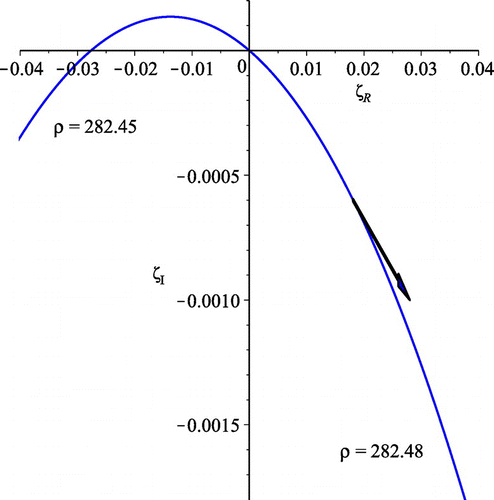
Before considering the implications of these observations, it is fair to ask if there are other such anomalies. A simple search leads to a study of the pair of zeros and
whose locus with increasing
is shown in Figure . It is easier to understand the situation here by considering Figure which, for clarity, is analogous to Figure but shows only
and
in the region between the two zeros under scrutiny. Here, we see that the situation is the exact opposite of the previous one. In the first configuration, the two zeros
and
were (suspiciously) too “close" to each other relative to the point where an anomaly can occur. This separation is, in turn, regulated by the slope of
defined in Equation (6.6) (see Equation (13.14) below). In the second configuration, the two zeros are too “far apart" for analogous reasons, and the discontinuity rises then falls, rather than the reverse. If
were moved 0.01 units to the left, and
were moved 0.2 units to the right, neither anomaly would occur. However, all the location values cited here have been checked against the original published tables (Odlyzko, CitationXXXX, file zeros1) and they are consistent with those presented there, as well as those used by Mathematica with which the Maple graphics presented here have been verified. Additionally, the locations of
and
have been verified by an independent calculation [A. Odlyzko, private communication].
At this point, it is worthwhile to recall three formulae that locate zeros. The first is the well-known Backlund (Edwards, Citation2001, p. 128) counting formula(9.4)
(9.4)
which (theoretically) increments by one at each point . The dotted line
in Figure shows that this is not true at the anomalous point
, where it decreases by unity, before it increases by 2 at the next half-zero. Recently, França and LeClair (Citation2013, Eq. 15) have proposed the counting function
(9.5)
(9.5)
based on the same (theoretical) assumption as used in Equation (9.4). The function is not explicitly shown in Figure because it coincides exactly with the Backlund result. In França and LeClair (Citation2013, Remark 6), it is written “
counts the zeros on the critical line accurately, i.e. it does not miss any zero"; Figure demonstrates that there exist small ranges of the critical line where this statement is, in principle, not correct.
A third relevant result taken from Milgram (Citation2011) predicts that “half-zeros corresponding to occur when
" - see Appendix 1. A simple asymptotic form is easily obtained from Equation (16.1)
(9.6)
(9.6)
Figure 12. Details of and
near the half-zero at
, showing that the two coincide, and are separate from a full zero. This also shows that the counting formula Equation (9.4) fails, but only in the anomalous region.
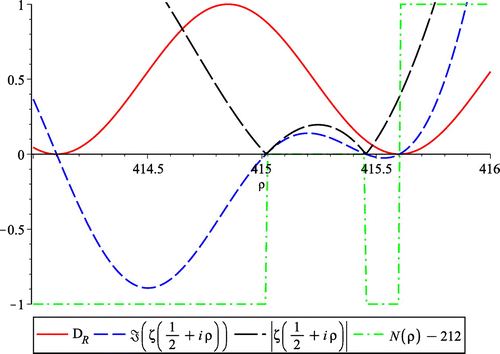
and Figure demonstrates that the half-zero that upper bounds the anomalous zeros and
is exactly where it is predicted to be according to Equation (9.6), which significantly does not depend on any numerical properties of the
-function. The first missing term of Equation (9.6) is of order
and is therefore negligible when
. The advantage of using Equation (9.6) is that numerically it only depends on simple trigonometric functions as well as the argument of
, all of which, it is reasonably safe to assume, are numerically accurate and reliable. In this way, the calculation will not involve possible cancellation of large numbers as might occur if Equation (16.1) were to be used. Although all the anomalies observed here involve very small values of
corresponding to values of the locus travelling close to the real axis, all these suggest that the effect, being examined here, appears to be self-consistent and is unlikely to reflect numerical artefacts. In summary, we must conclude that anomalous, imaginary half-zeros of
characterized by
do rarely, and unexpectedly, occur—a quick survey of the first 300 zeros suggests that in addition to the above,
and
may bound anomalous zeros. In addition, the Lehmer zeros (Edwards, Citation2001, Section 8.3) appear to share this property. As well as affecting counting formula such as Equation (9.4), the occurrence of such anomalies has implications for RH equivalences.
9.2. Consequences and a close look at the derivation of a 
 -function theorem
-function theorem
The analysis given in Section 8 depended on Equation (8.12) where the integral was split into segments, each of which was bounded by consecutive zeros , justified by the assumption that each discontinuous segment of
was separated from the continuous function
by
, constant over that segment. Each consecutive segment was labelled by unit increments of k. In fact, the equivalence of Equation (8.1) and Equation (8.19), independent of the presence of the term
as discussed, could have been taken as justification for that assumption. However, Figures and demonstrate that such is not the case due to anomalous zeros. With respect to Figure , the shaded region (orange), whose lower bound
is not part of the area bounded by
below, and
above, will nevertheless be included in the integration according to Equation (8.12). Thus, over this one segment, Equation (8.12) will over-estimate the true value of the integral by approximately
(9.7)
(9.7)
and the region marked “anomalous" in Figure will result in an underestimate by a numerically insignificant but non-zero result for similar reasons. Although both these anomalies are numerically insignificant, taken together with other anomalous values of that are almost certainly scattered along the critical line, one must conclude that Equation (8.1) and Equation (8.19) are analytically inconsistent, and we have a contradiction. Is this the long-sought contradiction in a RH equivalent discussed in Section 8? Unfortunately not. To understand why, it is necessary that the derivation of Equation (8.1) be revisited.
Referring to Sekatskii et al. (Citation2012), a typical RH equivalence is obtained by integrating a function F(z)g(z) around a well-chosen contour C in the complex z plane, then making a convenient choice of g(z). The integral is then related to the residue of enclosed singularities by the residue theorem, and it is simplified by taking one section of the contour of integration to coincide with a cut in the function F(z). This is achieved by choosing together with
. The critical statement is “An appropriate choice of the branches of the logarithm function assures that the difference between the two branches of the logarithm function appearing after the integration path indents the point
is
". On the surface, this is justified by the additional requirement that “f(z) is analytic and non-zero on C". And therein lies a problem.
If f(z) is analytic over a region, it does not follow that F(z) will be analytic over that same region. The simplest example showing that this is true, is to consider the case . In this case, f(z) is analytic, whereas
is cut. Thus, to assume that
will retain the same analytic characteristics as
and therefore integration over the same cut-structure as
will yield the same discontinuity is a fairly difficult assumption to justify. And as we have seen in the previous sub-section, it is not true. There are places along the logarithm cut where the difference, defined by F(z), between the two branches does not equal
. In fact, this occurs at precisely those points isolated previously and labelled “anomalous". Thus, if the derivation of Equation (8.1) had taken these regions into account, the statement of Equation (8.1) would have included terms precisely equal to those exemplified by Equation (9.7), thereby restoring consistency between (modified) versions of both Equation (8.1) and Equation (8.19). Thus, any RH equivalence of the Volchkov genre stated in the form Equation (8.1) without such terms is incorrect, and any numerical results based thereon must be treated with suspicion.
In a later work (Sekatskii et al., Citation2015), a more detailed exposition of the derivation of such equivalences is given. Using the same notation, we find written: “its (referring to F(z)) value jumps on when we pass a point
such that there is an
order zero or pole of the function f(z) lying inside the contour (and not on the integration line) and having the ordinate Y". As has been discovered, the existence of anomalous zeros demonstrates that discontinuities can occur at points other than a zero, and this eventuality must be incorporated into the resulting proofs.
A similar caution must be issued with respect to other results where similar assumptions (propositions?) are invoked. In França and LeClair (Citation2013, paragraph following Eq. 14), it is written “Possible discontinuities can only come from , and, in fact, it has a jump discontinuity by one whenever
corresponds to a zero". As we have seen here, the discontinuity varies between
near, but not always coincident with, an anomalous zero. In Titchmarsh (Citation1964, p. 58), we find written: “The behaviour of the function S(T) appears to be very complicated. It must have a discontinuity k where T passes through the ordinate of a zero of
of order k ... Between the zeros N(T) is constant...". Again, this is not true in the vicinity of an anomalous zero.
10. 

An immediate consequence of Equation (6.1) is:
Theorem 10.1
If , then
.
The proof is simple—if and
, then the left-side side of Equation (6.1) does not vanish, and therefore neither can the right-hand side. Except for the point
(see Section 3), since the denominator (contained in the factor
) does not vanish (which could cancel a numerator zero), both of
and
vanishing together would lead to a contradiction. Therefore,
.
This extends previously known results (Spira, Citation1973) onto the perforated critical line without recourse to RH.
Note 1: From Equation (2.5), has a pole at only one point
, and since it is known that
is not infinite, it must be that
at
in order to cancel the pole of
. This has been verified numerically. If
and
do not vanish, this is the only point where this can occur—otherwise, it would contradict Equation 7.8.
Note 2: It is worthwhile to recall from (Conrey, Citation1983a), (slightly edited): “It can be shown that RH implies that all zeros of ...have
, ... subject to simplicity (Conrey, Citation1983b)", and further (Conrey & Gosh, Citation1990), “Montgomery and Levinson proved ...
vanishes on
only at a multiple zero of
(hence probably never)". Titchmarsh (Citation1964, p. 79) writes:“If Mertens’ hypothesis is true, all the zeros of
are simple".
11. Asymptotics
Equation (6.1) together with Equations (6.6 and 7.8) is equivalent to Equation (2.13), and taken together demonstrate that asymptotically, and
approach their limits differently as
. That is,
(11.1)
(11.1)
because it is known (Olver et al., Citation2010, Eq. 5.11.2), and easily verifiable, that(11.2)
(11.2)
Within a term proportional to , Equation (11.1) is almost an equality. By way of contrast, direct differentiation of Equations (2.2 and 2.4) gives
(11.3)
(11.3)
and from Equations (11.1 and 11.3), we find a simple identity(11.4)
(11.4)
Integrating Equation (11.3) between limits and
gives
(11.5)
(11.5)
which, lacking an explicit analytic expression for , “might be hard" to evaluate. Notice that if either of
or
coincides with a zero of
, the right-hand side of Equation (11.5) must diverge, consistent with Equation (7.8) (see Olver et al., Citation2010, Eq. 4.21.4), and if
and
enclose one or more zeros of
, the integrand acquires singularities and the integral diverges. However, Equation (11.5) has been verified by numerical integration within a few small intervals where these events do not occur.
From Equation (2.9), we establish the asymptotic limit(11.6)
(11.6)
demonstrating that the real and imaginary parts of scale to the same order of
, subject to an (infinitely varying) modulating function given by the right-hand side of Equation (11.6). From Equation (11.1), it is also a simple matter to establish that
(11.7)
(11.7)
or(11.8)
(11.8)
demonstrating that corresponding components of and its derivative scale differently at large values of
, consistent with Equation (11.1). Numerically, both these results are excellent estimates for even reasonably small values of
because the secondary terms that have been omitted are all of order
.
All of these results can be understood by considering the relationship that exists between the real and imaginary components of and
presented in Equations (4.9a and 4.9b)—it is the factor
from which the scaling factor
originates since all the coefficients identified in Equations (4.10 and 4.11) are
.
Finally, with reference to Equations (6.16 and 6.17), we have, to leading orders, (and reversing the sign for convenience) the very accurate approximation,(11.9)
(11.9)
In contrast, in Titchmarsh and Heath-Brown (Citation1986, p. 229, Theorem 9.15), it is written: “ uniformly for
". For an application, see Section 13.
12. Counting the zeros
Contingent on Equation (8.2) and issues raised in Section 9, we see that as increases past a zero, the value of k in Equation (6.9) increments by one, so at any value
, the lower integer (floor) limit of k, indicated by
, and computed as
(12.1)
(12.1)
will be equal to the number of zeros . The result (Equation 12.1) is exact, but suffers from some inconsistency as an independent enumerator because it includes a (small) term that involves
itself (however, see França & LeClair, Citation2013, Remark 5). As a means of determining the location of the
zero, since Equation (12.1) is exact, the floor function can be used to immediately pick out a discontinuity in k that heralds the existence of a zero as
changes, to any desired degree of numerical accuracy. As an aid to computation, Equation (12.1) can be simplified by noting that Equation (6.9) is amenable to integration by parts, yielding the alternative representation
(12.2)
(12.2)
where denotes the LogGamma function (Wolfram MathWorld, Citation2005) and, for large values of T, asymptotically, the right-hand side of Equation (12.2) is very well approximated (Maple). So, the first few terms of the asymptotic limit
in Equation (12.1) are
(12.3)
(12.3)
the first two terms of which equate to the well-known result first suggested by Riemann and proven by von Mangoldt (Borwein et al., Citation2008, Theorem 2.9). The higher order terms can be found in Edwards (Citation2001, Section 6.7). The last term in Equation (12.3) originates from the discontinuous term in Equation (12.1), whose asymptotic limit, being unknown, perhaps unknowable, has been included in terms of its possible bounds
. The traditional proof of von Mangoldt’s result given at great length in Borwein et al. (Citation2008), and discussed in Titchmarsh (Citation1964, p. 5, Eq. 18) includes a third term
, representing an average value of the term
, which must vary continuously (and randomly?) between its bounds over any small range of T, asymptotic or not, because it is known that the number of zeros are infinite (Titchmarsh, Citation1964, Theorem 31). The constant term (
) that is given here differs from terms given in Titchmarsh (Citation1964) and Edwards (Citation2001, Section 6.7) (i.e.
and 7 / 8, respectively) and is, according to Equation (6.8), an arbitrary normalization constant to begin with.
13. The density and distribution of zeros
In addition to the above estimates, Equation (11.9) leads to other useful approximations. Since it has been shown (see Section 9) that consecutive zeros on the critical line are (almost always) bounded by half-zeros , (see Gram points (Edwards, Citation2001, p. 125)) the very accurate asymptotic estimate mod(
can be used to place bounds on the location of consecutive zeros since each time
,
will pass through a multiple of
. With
defined in Equation (11.9), Figure illustrates this bounding procedure by plotting the normalized asymptotic counting function
(13.1)
(13.1)
as a function of for a region of previous interest (see Section 9). The absolute count value is given by
, and the solution of the equation
(13.2)
(13.2)
which defines an upper bounding point defined by
, is given by
(13.3)
(13.3)
in terms of Lambert’s W function (Maple). As seen in the Figure, bounds all zeros except the anomalous ones investigated in Section 9. However, as in the case of Equation (9.4), it “catches up" at the next bounding point. The accuracy of
as an upper bound counting function has been confirmed for the first 10,000 zeros
. Using the same principles, a similar result can be obtained from Equation (9.6), where
whenever
(13.4)
(13.4)
As a comparison to Equation (13.3), França–LeClair (Citation2013) find an expression that locates the zeros reasonable accurately, that being(13.5)
(13.5)
It is interesting to compare the two approximations, by calculating the following four quantities(13.6)
(13.6)
(13.7)
(13.7)
(13.8)
(13.8)
(13.9)
(13.9)
each of which, respectively, measures the distance from
the França-LeClair approximation to the known zero it is approximating;
an upper bound to the next lower known zero;
the lower bound up to the next higher known zero;
the average of the upper and lower bounds to the bounded, known zero.
Figure 13. as a function of
plotted over a region of previous interest, along with
to indicate the location of the zeros. The circle indicates the location of an anomalous zero.
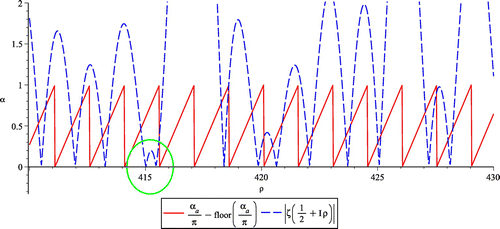
Table 1. Statistical comparison of various measures of the distribution of zeros
For an estimate of the distribution of zeros at large values of , similar to those given in França and LeClair (Citation2013), from Equation (11.9) consider two consecutive bounding points
(13.10)
(13.10)
and(13.11)
(13.11)
with . Solving Equations (13.11 and 13.12) to first order in
, we find the measure of a bucket that bounds successive zeros at large values of
, that being
(13.12)
(13.12)
from which it is possible to estimate the density of zeros, i.e. the number of zeros that lie between unit intervals of
, specifically
(13.13)
(13.13)
Note that Equation (13.12) is the incarnation of Titchmarsh (Citation1964, Theorem 41) on the critical line (“the gaps between the ordinates of successive zeros of tend to zero”). See also Titchmarsh and Heath-Brown (Citation1986, Theorems 9.12 and 9.14). An interesting consequence of these considerations yields an estimate of the maximum possible discontinuity between successive zeros at large values of
. If, for some
and
in the range
, this maximum value, estimated by
, were less than
, then ALL zeros would be anomalous for
, and all existing counting theorems would fail. However, from Equations (6.6 and 13.13), we find
(13.14)
(13.14)
so this possibility does not occur because the gap distance and the slope of the argument both vary in magnitude at the same rate (at least to first order in ).
As an example, from published tables (Odlyzko, CitationXXXX, file zeros5), at corresponding to
, we find
. Consistently, the tables list exactly seven zeros between
corresponding to
and
corresponding to
. Similarly, there are eight listed between
corresponding to
and
corresponding to
. As noted, each of these ranges corresponds to values of
separated by one unit. The predicted gap size enveloping zeros for this range of k is
, comparable to the average observed distance between the seven zeros which is 0.1460. In this range, the maximum possible predicted distance between zeros is
; the largest observed gap between the seven zeros is 0.221.
For larger values of , the reader can estimate
from Figure . For extremely large values of
, numerical evaluation of the function W could be reasonably suspect since no details about the asymptotic evaluation of the W function are given in Maple’s FunctionAdvisor. In the case of Mathematica, we find (Wolfram Mathworld, Citation2002) a complicated asymptotic expansion accurate to order
(13.15)
(13.15)
With , this suggests
which might affect calculations that must be done in multiple precision (
100 digit) arithmetic. This can be checked using Equations (13.2 and 11.9) which only involves the
function, presumably numerically trustworthy for large values of its argument. Define
. In França and LeClair (Citation2013), with
, Table lists
to 102 digit accuracy. Substituting
in Equations (13.2 and 11.9), and assuming that
is not anomalous, we obtain
, a negligible discrepancy, given that
in França and LeClair (Citation2013) as presented is accurate to only the first digit beyond the decimal point, implying an inherent error greater than the size of the expected range boundaries (see below) at these values of k.
Performing the reverse test, let and
in Equation (13.3) to obtain the bounding points of
. It was found that
is predicted to lie 0.013 units below the upper bound, and .014 units above the lower bound, exactly as specified in França and LeClair (Citation2013). Furthermore, since the expected size of the distance between bounds at
is 0.0279, all of this is self-consistent and appears to be acceptably accurate. Verification of the case(s)
(and beyond), discussed in França and LeClair (Citation2013), is left as an exercise for the ambitious reader.
14. Summary
In this work, an exploratory approach has been used to obtain insights into the nature of Riemann’s zeta function and its zeros in the critical strip. Specializing to the critical line, the method reproduces and expands upon a known result for locating the zeros, and yields a novel derivation of the argument of the zeta function by means of a differential equation. The discovery that a simple, singular, linear transformation exists between the real and imaginary components of and
on the critical line is undoubtedly significant. The analytic representation of
in turn supplies further insights, notably related to the Volchkov equivalence, a counting formula and the distribution of zeros asymptotically.
Of import, a study of the location of zeros led to the numerical discovery of anomalous zeros, and the suggestion that many previous results (e.g. Volchkov-type RH equivalents) that did not take these into account require revision. From the derived equation for , it is shown, independent of RH, that
does not vanish on the perforated critical line. Since much has been written about the zeta function over the years, it is recognized that some of the results given here may not be new, but it is suspected that those results based on Equation (6.1) are new. At a minimum, the analyses given here do not follow usual textbook derivations and gather many disparate results in one place.
Regarding RH, it has been written (Ivic, Citation1985, p. 50) that “the functional equation for in a certain sense characterizes it completely". In fact, Titchmarsh and Heath-Brown (Citation1986, Section 2.13) demonstrate that, with general assumptions, the functional equation defines the zeta function. Here, it has been shown that many known (and possibly new) properties of the zeta function on the critical line can be obtained by studying only the functional equation, and some results can be obtained independently of RH, in contrast to equivalent results usually cited that require RH to be true. For future investigation, a very significant advance would be accomplished by the discovery of a relationship analogous to Equation (6.6) for the argument function
, since Equations (7.6) and or (7.8) show that the location of the non-trivial zeros on the critical line is defined by the two argument functions
and
alone. The extension of Equation (13.15) to higher orders of
would clarify how frequently anomalous zeros are expected to occur, and a proof that, in Equation (4.7), the factor enclosed in square brackets is non-zero would be useful. As well, further investigation into the consequence(s) of the existence of anomalous zeros on various accepted results is warranted. For example, the derivation of Volchkov and related equivalences and various counting theorems should be carefully and rigorously revisited.
Supplementary_material.pdf
Download ()Acknowledgements
I am grateful to Larry Glasser, who, over the past few years, has subjected me to a barrage of new, fascinating and wonderful insights into mathematical methods and results at a rate far faster than I could give them the attention they deserve. By a very circuitous route, the present work resulted from one such missive. Consequently, I am dedicating this paper to the memory of Larry’s wife Judith Glasser. Larry, Judith and I enjoyed a memorable afternoon at a coffee shop in the border city of Cornwall, Ontario, several years ago, which led to my recent collaboration with Larry and the several papers that resulted. The author thanks Larry and Vini Anghel for a perusal of the preliminary manuscript. I also thank an anonymous referee who suggested the derivation of Equation (5.2) as it is now presented here, being orders of magnitude simpler than my original derivation.
Additional information
Funding
Notes on contributors
Michael Milgram
The author has spent most of his career studying and applying mathematics to problems in Physics and Engineering. This led him to develop some expertise in the mathematical field of Special Functions, which in turn led to an interest in the Zeta function, as a diversion from his everyday pursuit of solutions to problems in Monte Carlo simulation and computer-aided visualization of CNC machining.
References
- Abramowitz, M., & Stegun, I. (1964). Handbook of mathematical functions. New York, NY: Dover.
- Borwein, P., Choi, S., Rooney, B., & Weirathmueller, A. (2008). The Riemann hypothesis : A resource for the afficionado and virtuoso alike (CMS books in mathematics). New York, NY: Springer.
- Conrey, Brian (1983a). Zeros of derivatives of Riemann’s ξ-function on the critical line. Journal of Number Theory, 16, 49–74.
- Conrey, B. (1983b). Zeros of derivatives of Riemann’s ξ-function on the critical line. II. Journal of Number Theory, 17, 71–75.
- Conrey, J. B., & Farmer, D. W. (n.d.)Equivalences to the Riemann hypothesis. Retrieved from https://web.archive.org/web/20120731034246/http://aimath.org/pl/rhequivalences
- Conrey, J. B., & Ghosh, A. (1990). In B. Berndt, H. Diamond, H. Halberstam, & A. Hildebrand (Eds.), Zeros of derivatives of the Riemann zeta-function near the critical line. Boston, MA: Birkh\"{a}user
- de Reyna, J.A., & Van de Lune, J. (2014). On the exact location of the non-trivial zeros of Riemann’s Zeta function. Acta Arithmetica, 163, 215–245. Retrieved from http://arxiv.org/pdf/1305.3844v2.pdf;2013,doi:10.4064/aa163-3-3
- Edwards, H. M. (2001). Riemann’s zeta function. Mineola, NY: Dover Publications.
- England, M., Bradford, R., Davenport, J. H., & Wilson, D. (2013). Intelligent computer mathematics: MKM, calculemus, DML, and systems and projects 2013, Held as Part of CICM 2013, Bath, UK, July 8--12, 2013. Proceedings chapter Understanding Branch Cuts of Expressions (pp. 136–151).Berlin Heidelberg: Springer. Retrieved from http://arxiv.org/abs/1304.7223
- Fran\c{c}a, G., & LeClair, A. (2013, July). Statistical and other properties of Riemann zeros based on an explicit equation for the n-th zero on the critical line. ArXiv e-prints. Retrieved from http://arxiv.org/abs/1307.8395
- Gradshteyn, I. S., & Ryzhik, I. M. (1980). Tables of integrals, series and products, corrected and enlarged edition. New York, NY: Academic Press.
- Guillera, J. (2013, July). Some sums over the non-trivial zeros of the Riemann zeta function. Retrieved from http://arxiv.org/abs/1307.5723v7
- Hansen, E. R. (1975). A table of series and products. Englewood Cliffs, NJ: Prentice-Hall.
- He, Y. H., Jejjala, V., & Minic, D. (2015, January). From Veneziano to Riemann: A string theory statement of the Riemann hypothesis. arxiv.org/pdf/1501.01975.
- Ivi{\’c}, A. (1985). The Riemann zeta-function: Theory and applications. Mineola, NY: Dover.
- Maplesoft, A Division of Waterloo Maple. (XXXX). Maple.
- Milgram, M. S.(2011). Notes on the zeros of Riemann’s Zeta function. Retrieved from http://arxiv.org/abs/0911.1332
- Moll, V. H. (2010). Seized opportunities. Notices of the American Mathematical Society, 57(4). Retrieved from http://www.researchgate.net/publication/265488191
- NIST Digital Library of Mathematical Functions. (2014). New York, NY: Cambridge University Press. Retrieved from http://dlmf.nist.gov/ (Release 1.0.9 of 2014-08-29).
- Odlyzko, A. (XXXX). Tables of zeros of the Riemann zeta function. Retrieved from http://www.dtc.umn.edu/~odlyzko/zetatables/index.html
- Olver, F. W. J., Lozier, D. W., Boisvert, R. F., & Clark, C. W. (Eds.). (2010). NIST handbook of mathematical functions. New York, NY: Cambridge University Press.
- Sekatskii, S. K., Beltraminelli, S., & Merlini, D. (2009, April). A few equalities involving integrals of the logarithm of the Riemann zeta-function and equivalent to the Riemann hypothesis II. ArXiv e-prints. Retruved from http://arxiv.org/abs/0904.1277
- Sekatskii, S. K., Beltraminelli, S., & Merlini, D. (2012). On equalities involving integrals of the logarithm of the riemann ζ-function and equivalent to the riemann hypothesis. Ukrainian Mathematical Journal, 64, 247–261.
- Sekatskii, S. K., Beltraminelli, S., & Merlini, D. (2015). On equalities involving integrals of the logarithm of the Riemann-function with exponential weight which are equivalent to the Riemann hypothesis. International Journal of Analysis. doi:10.1155/2015/980728
- Spira, R. (1973). Zeros of ζ’(s) and the Riemann hypothesis. Illinois Journal of Mathematics, 17, 147–152.
- Titchmarsh, E. C. (1964). The zeta-function of Riemann. New York: Stechert-Hafner Service Agency.
- Titchmarsh, E. C., & Heath-Brown, D. R. (1986). The theory of the Riemann zeta-function (2nd ed.).Oxford: Oxford Science Publications.
- Volchkov, V. V. (1995). On an equality equivalent to the Riemann hypothesis. Ukrainian Mathematical Journal, 47, 491–493.
- Weisstein, E. W.. (2002). Lambert W-function. MathWorld--A Wolfram Web Resource. Retrieved from http://mathworld.wolfram.com/LambertW-Function.html
- Weisstein, E. W. (2005). Log gamma function. MathWorld--A Wolfram Web Resource. Retrieved from http://mathworld.wolfram.com/LogGammaFunction.html
- Wolfram MathWorld. (XXXXb). Log gamma function. Retrieved from http://mathworld.wolfram.com/RiemannZetaFunction.html
Appendix 1
Appendix—definitions and symbols
The following symbols and definitions appear throughout this paper. Subscripts I and R refer to the imaginary and real components of the symbol to which they are attached. The unmodified symbols ,
,
and
mean
,
,
and
, respectively, along with their appropriate subscripts;
is the digamma function (
.
refers to the real or imaginary component of the derivative of
with respect to
, whereas
refers to the derivative of the real or imaginary component of
with respect to
(see Equations (6.3 and 6.4). All other symbols carry implicit functional dependence on
, usually omitted for brevity, except where required for clarity. The variables n, k are always positive integers, and K is an integer. The symbol
refers to a generic value of
corresponding to
, whereas
refers to a specific value of
.
(A.1)
(A.1)
(A.2)
(A.2)
(A.3)
(A.3)
(A.4)
(A.4)
(A.5)
(A.5)
(A.6)
(A.6)
(A.7)
(A.7)
(A.8)
(A.8)
(A.9)
(A.9)
(A.10)
(A.10)

